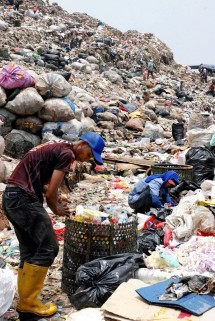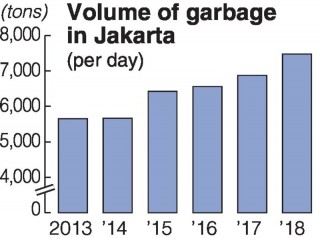Loading
Search
▼ Japanese Firms See Opportunity In S.E. Asia Garbage
- Category:Other
JAKARTA — The rapid economic development experienced across Southeast Asia has created a serious garbage problem, as growing volumes of rubbish highlight a shortage of disposal sites.
But in this problem lies an opportunity for Japanese companies with incineration expertise to begin the urgent task of constructing badly needed disposal facilities.
35-meter mountain of waste
At a waste treatment site in Bantar Gebang, in the suburbs of Jakarta, about 7,500 tons of garbage is collected and carried out of the capital by truck every day. The amount of garbage at this site has increased year by year, accumulating on the 82-hectare plot into a pile that is 35 meters tall at the highest point, literally creating “a mountain of garbage.”
“In five years, there will be no space here to dispose of garbage,” a 35-year-old employee of the facility said with a sigh.
This situation is not limited to the Bantar Gebang site. At most disposal sites across Southeast Asia, municipal solid waste is collected and piled up at a single site as an open dump. As economic development continues, every country in the region is finding the problem of garbage disposal increasingly difficult to tackle without incinerators.
In Indonesia, President Joko Widodo announced in April 2018 that the country had made plans to build garbage incineration sites in 12 urban cities.
With support from the Japan International Cooperation Agency (JICA), a project has been under way to build the country’s first large-scale incineration facility in Legok Nangka, about 150 kilometers southeast of Jakarta. In recent years, the construction of garbage incineration sites has begun also in other countries such as Malaysia, the Philippines and Myanmar.
But in this problem lies an opportunity for Japanese companies with incineration expertise to begin the urgent task of constructing badly needed disposal facilities.
35-meter mountain of waste
At a waste treatment site in Bantar Gebang, in the suburbs of Jakarta, about 7,500 tons of garbage is collected and carried out of the capital by truck every day. The amount of garbage at this site has increased year by year, accumulating on the 82-hectare plot into a pile that is 35 meters tall at the highest point, literally creating “a mountain of garbage.”
“In five years, there will be no space here to dispose of garbage,” a 35-year-old employee of the facility said with a sigh.
This situation is not limited to the Bantar Gebang site. At most disposal sites across Southeast Asia, municipal solid waste is collected and piled up at a single site as an open dump. As economic development continues, every country in the region is finding the problem of garbage disposal increasingly difficult to tackle without incinerators.
In Indonesia, President Joko Widodo announced in April 2018 that the country had made plans to build garbage incineration sites in 12 urban cities.
With support from the Japan International Cooperation Agency (JICA), a project has been under way to build the country’s first large-scale incineration facility in Legok Nangka, about 150 kilometers southeast of Jakarta. In recent years, the construction of garbage incineration sites has begun also in other countries such as Malaysia, the Philippines and Myanmar.
Top-level technology, expertise
Japan, which needs to dispose of a large amount of waste within its small territory, has developed top-level technology and expertise in building incineration facilities.
State-of-the-art facilities built by Japanese companies, including Hitachi Zosen Corp. and JFE Engineering Corp., also generate power in the incineration process, which allows an early recovery of construction costs. In fact, about 30 percent of the existing incineration facilities in Japan — approximately 1,100 in total — are capable of generating power.
Japanese companies have increasingly received orders from Europe and other regions, and Southeast Asia is attracting attention as a promising market.
Given the situation, Japanese companies are conscious of Chinese competitors. Already in Thailand, Chinese companies have received an increasing number of orders by offering lower prices. However, there have been complaints about failures, insufficient power-generation capacity and other problems at incineration facilities built by Chinese companies since they went into operation.
Competition between Japanese and Chinese companies is likely to intensify over both quality and price.
Japan, which needs to dispose of a large amount of waste within its small territory, has developed top-level technology and expertise in building incineration facilities.
State-of-the-art facilities built by Japanese companies, including Hitachi Zosen Corp. and JFE Engineering Corp., also generate power in the incineration process, which allows an early recovery of construction costs. In fact, about 30 percent of the existing incineration facilities in Japan — approximately 1,100 in total — are capable of generating power.
Japanese companies have increasingly received orders from Europe and other regions, and Southeast Asia is attracting attention as a promising market.
Given the situation, Japanese companies are conscious of Chinese competitors. Already in Thailand, Chinese companies have received an increasing number of orders by offering lower prices. However, there have been complaints about failures, insufficient power-generation capacity and other problems at incineration facilities built by Chinese companies since they went into operation.
Competition between Japanese and Chinese companies is likely to intensify over both quality and price.
Concerns over local opposition
At the same time, there is an issue peculiar to emerging countries regarding the livelihoods of so-called waste pickers.
These manual laborers make their living by collecting and reselling recyclable materials such as plastic bottles and metals from open-dump disposal sites. About 10,000 people are said to make a living this way around disposal sites in the suburbs of Jakarta.
Because petrochemical products such as plastic bottles provide an energy source in the incineration process, continuing to allow waste picking could affect the efficiency of a disposal facility’s power generation benefit.
An official at one of the Japanese plant makers acknowledged this, saying that the construction of such facilities would “take jobs from many people and could lead to vehement opposition movements.”
At the same time, there is an issue peculiar to emerging countries regarding the livelihoods of so-called waste pickers.
These manual laborers make their living by collecting and reselling recyclable materials such as plastic bottles and metals from open-dump disposal sites. About 10,000 people are said to make a living this way around disposal sites in the suburbs of Jakarta.
Because petrochemical products such as plastic bottles provide an energy source in the incineration process, continuing to allow waste picking could affect the efficiency of a disposal facility’s power generation benefit.
An official at one of the Japanese plant makers acknowledged this, saying that the construction of such facilities would “take jobs from many people and could lead to vehement opposition movements.”
- January 29, 2019
- Comment (0)
- Trackback(0)




